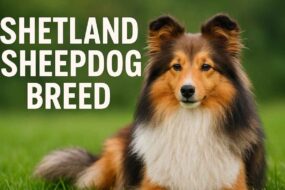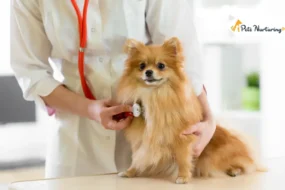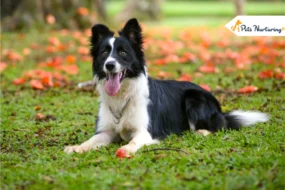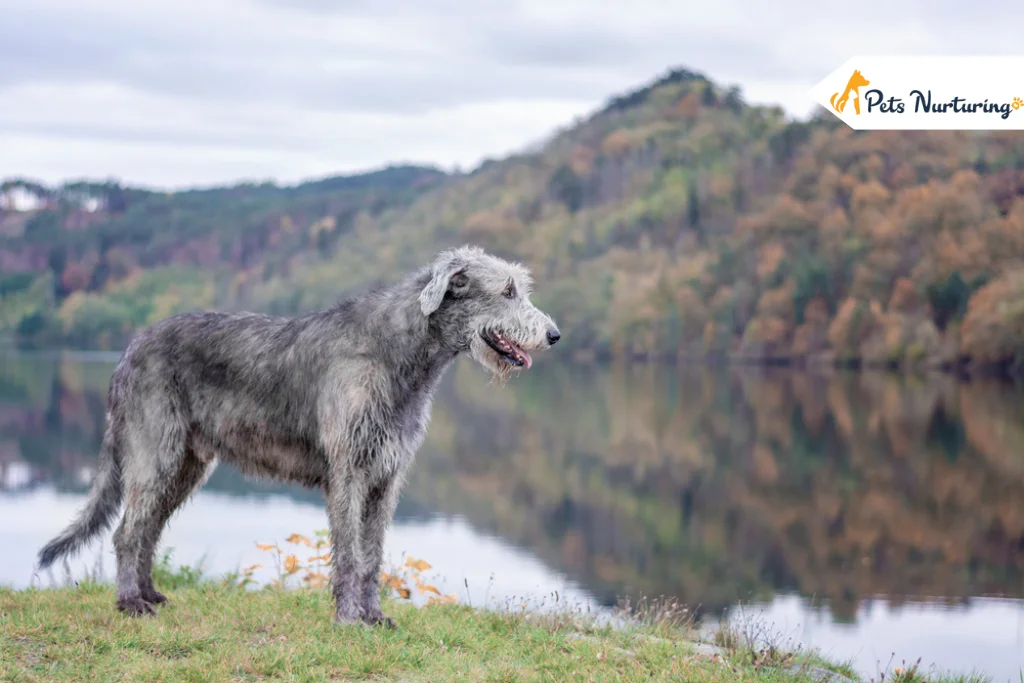
The Irish Wolfhound Dog is an amazing breed with a rich history. Originally, these dogs were used in wars to pull men off horses and chariots. Today, they’ve adapted to become wonderful family pets, excelling in activities like obedience and tracking.
One striking feature of Irish Wolfhounds is their impressive size. They’re usually the tallest among all dog breeds. Keep in mind that even though they start off small and cute as puppies, they grow rapidly.
For families with ample space, Irish Wolfhounds are great pets, especially with children. Just be sure to have a tall fence to prevent them from jumping. If you want to know more about this dog breed, keep reading.
In this guide, we are going to cover their origin, characteristics, behavior, and care tips.
Breed Overview
Meet the Irish Wolfhound, the biggest dog breed originating from Ireland. These giant hounds can reach up to 7 feet tall when standing on their hind legs.
Despite their imposing size, Irish Wolfhounds dogs are truly gentle giants with a calm demeanor, making them wonderful companions—especially if you have enough space for them.
Originally bred for big game hunting, they’ve transitioned to become primarily family dogs.
Learn more about this lovable giant with this guide.
Irish Wolfhound Breed Overview
Breed Group: Hound
Height: Male – at least 32 inches ; Female – at least 30 inches
Weight: Male – at least 120 pounds ; Female – at least 105 pounds
Lifespan: 6 to 8 years
Coat: Medium-length, wiry double coat
Color: Various colors (blue, brindle, gray, red, black, white and more)
Temperament: Gentle, calm, and affectionate
Grooming Needs: Regular brushing to maintain coat health
Hypoallergenic: No
Origin: Ireland
History
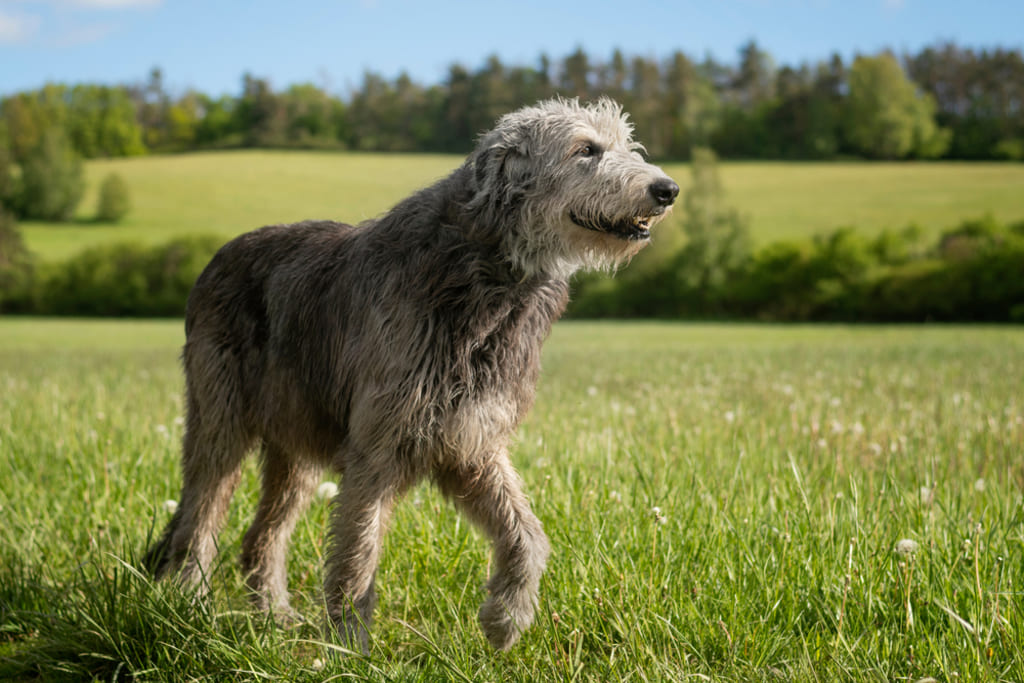
The Irish Wolfhound has a fascinating history, filled with myths and legends dating back to ancient times. The first recorded mention goes back to 391 AD in ancient Rome, where Roman Consul Quintus Aurelius obtained seven Irish wolfhounds as a gift.
These majestic dogs were cherished by the nobility, including figures like Elizabeth I of England, Henry VIII, and Henry IV of France. They were often exchanged as gifts between friendly kingdoms.
In Ireland, these large sighthounds gained fame among chieftains and were valued for hunting large game. In the 15th century, they were enlisted to help control the overpopulation of wolves in Ireland.
Their courage and hunting prowess were so remarkable that, by the 1700s, they nearly vanished as they successfully cleared the Irish land of big-game animals. With the decline in hunting demand, the Irish Wolfhound became a multipurpose farm dog and was rarely bred.
In 1862, a British army captain named George Augustus Graham became enamored with these gentle giants. Determined to protect, standardize, and revitalize the breed, Graham initiated a breeding program. Dogs native to Britain were crossed with hounds from the Middle East, acquired through trade.
He crossed the Irish Wolfhound with the Borzoi, Glengarry deerhound, Great Dane, and Tibetan mastiff. The Irish wolfhounds of today are a legacy of Graham’s efforts.
The American Kennel Club officially recognized the Irish Wolfhound in 1897. This period marked a crucial chapter in the survival and recognition of these majestic dogs.
Appearance
The archaic Irish wolfhound puppy carries itself with fineness and a strong presence. Despite their imposing size, these gentle dogs have a considerate face and an adorable expression.
Bred for hunting big games in the Irish country, they belong to the giant or extra-large breed category, boasting a muscular yet elegant build.
Being a sighthound, these giants rely on visual perception while hunting. They have a muscular and moderately long neck, and they carry their head high.
A full-grown male Irish Wolfhound is at least 32 inches tall at the shoulder and weighs a minimum of 120 pounds. Females are a bit shorter, reaching a height of at least 30 inches and tipping the scales at 105 pounds.
| Characteristic | Male | Female |
| Height | At least 32 inches | At least 30 inches |
| Weight | Minimum 120 pounds | Minimum 105 pounds |
Coat and Color
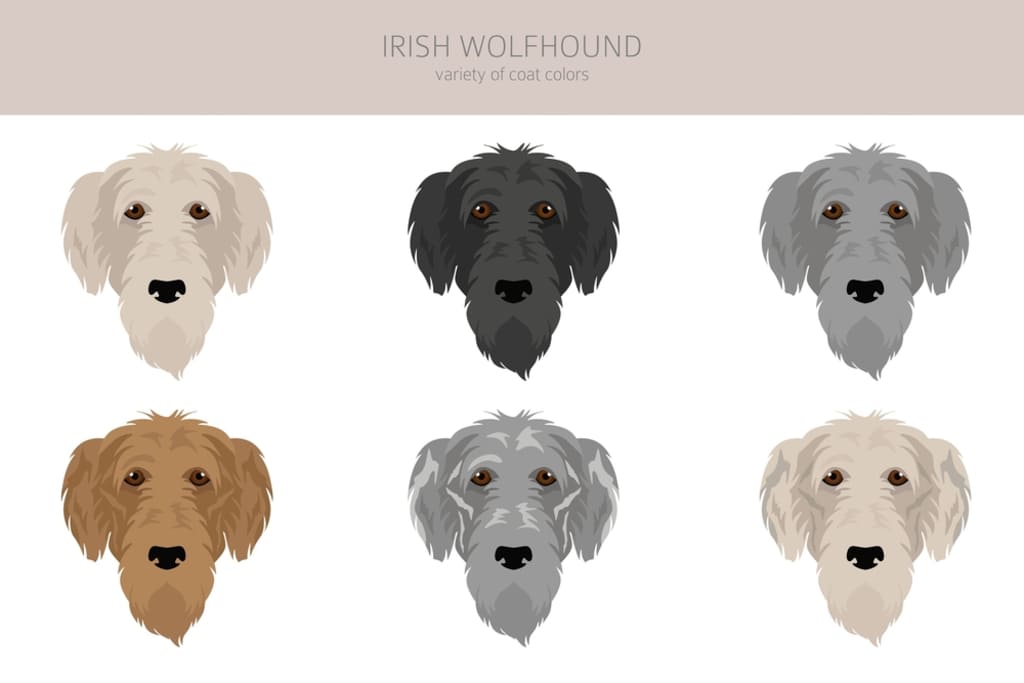
To brave the sometimes brutal Irish weather, these dogs sport a double coat. They have a soft undercoat, providing insulation in all climate conditions. The longer, harsher, and wirier top coat is more noticeable past the eyes and underneath the jaw, resembling a beard and eyebrows.
The Irish wolfhound puppy comes in various patterns and colors, with those acknowledged by the American Kennel Club, including,
- Black
- Brindle
- Blue
- Gray
- Silver
- Red
- Wheaten
- White
Their coat is rugged and coarse, especially on the head, body, and legs. The beard and hair over the eyes are notably wiry. These dogs are among the best large white dog breeds in the world.
Characteristics and Temperament
Irish Wolfhounds, despite their imposing size and hunting record, are among the calmest, serene, and kindest dog breeds globally. They’re smart and inquisitive, finding their utmost happiness when strolling outdoors alongside their owners.
It’s worth noting that these dogs take quite a while to mature as puppies. So, you might find yourself with a big puppy that doesn’t always act its age. This can be a bit challenging, especially for pet owners who are looking for more mature behavior and a dog that isn’t always full of energy.
These gentle giants are affectionate and forbearing with kids, making them a great fit for households with sufficient space and resources for a dog of this dimension. Like any breed, proper socialization from a young age is crucial.
Well-socialized dogs can get along with kittens and other pets, although they might prefer being the only dog. Due to their size, there’s a chance they could accidentally startle smaller children, so they tend to fare better in homes with older kids. It’s essential to train kids how to interact properly with dogs and to always supervise their playtime with any pet.
This type of Hound dog is among the best low energy dog breeds in the world. Although they aren’t really energetic, they do need plenty of space to move around due to their large bodies.
- Affection Level: High, loves to show affection
- Friendliness: Medium, generally friendly
- Pet-Friendly: High, gets along well with other pets
- Kid-Friendly: Medium, moderate suitability for kids
- Playfulness: Medium, enjoys play but is not overly playful
- Exercise Needs: High, requires regular and active exercise
- Intelligence: Medium, possesses moderate intelligence
- Trainability: Medium, moderate ease in training
- Energy Level: Medium, moderate energy levels
- Amount of Shedding: Medium, moderate shedding levels
- Tendency to Bark: Low, not prone to excessive barking
Health and Nutrition
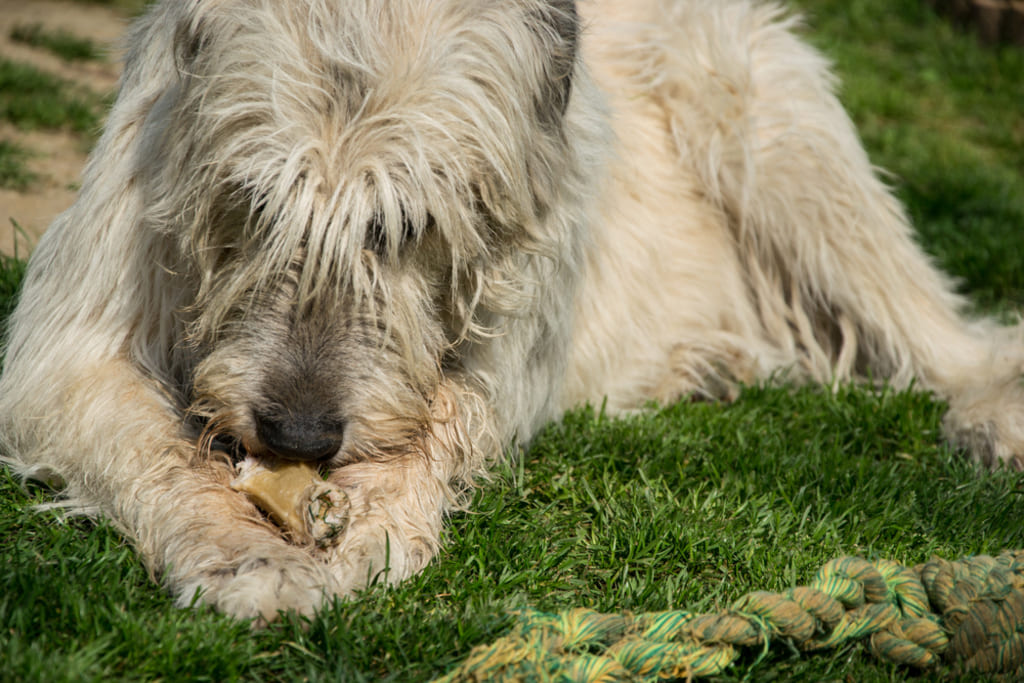
Ensuring your Irish Wolfhound puppy gets a complete and balanced diet is important. Opting for commercial kibble or wet food that meets the standards set by the Association of American Feed Control Officials (AAFCO) is a reliable way to achieve this.
Irish Wolfhound puppies, being a giant breed, need to grow steadily to ensure their muscles and bones develop harmoniously. Rapid growth can lead to weak bones and joints, making them prone to issues like hip and elbow dysplasia.
To support healthy growth, it’s essential to provide the right amounts of fat, protein, and carbohydrates. AAFCO-compliant foods designed for giant and large-breed dogs are a good choice but always consult with your vet to find the best diet for your dog.
Feeding an adult Hound dog every 12 hours is ideal, and using raised food and water bowls should be avoided to reduce the risk of bloat.
Determining the right amount of meals relies on elements like metabolism, size, and action level. Your veterinarian can guide you, and the feeding guide labels on your chosen dog food are helpful, too. Keeping your dog at a healthy weight is crucial for protecting their joints.
Think about adding (DHA/EPA) omega-3 fatty acids to their diet. They can be seen in fish oil, skin, and joint supplements, or specially cultivated doggy foods. Omega-3 fatty acids act as natural anti-inflammatories, supporting the skin, joints, kidneys, coat, and heart of your Irish Wolfhound.
Always provide your dog with fresh water, and be prepared for a substantial food budget to cater to the needs of this large breed. Most owners opt for two measured meals each day, choosing a dog food specifically formulated for large breeds to ensure proper nutrition.
Mindful feeding is essential to prevent your dog from becoming overweight, which can strain their joints. Watch out for treats and extra food, and maintain a balanced diet.
Common Health Problems
Taking care of an Irish Wolfhound puppy comes with the responsibility of being aware of some significant health concerns. Despite proper care, these gentle giants have a shorter life expectancy, typically around 7 years, which is shorter compared to smaller breeds.
1. Gastric Dilatation-Volvulus (Bloat, GDV)
Bloat is a sudden and severe condition where the stomach fills with gas or food, leading to expansion and pressure. In Irish Wolfhounds, with their deep chest, there’s an increased risk. Immediate veterinary attention is crucial, as untreated cases can result in shock or even death.
Symptoms include non-productive retching, a swollen abdomen, drooling, and collapse. To prevent bloat, a procedure called prophylactic gastropexy can be done, securing the stomach to avoid twisting.
2. Bone Cancer (Osteosarcoma)
These dogs are predisposed to osteosarcoma, an aggressive bone cancer often showing as lameness or limping. Treatment usually involves pain control, followed by the removal of the affected area, often requiring limb amputation. Chemotherapy is recommended to slow down the cancer’s spread.
3. Hip Dysplasia
Hip dysplasia occurs when the hip joint doesn’t develop properly, leading to a loose joint. This can cause arthritis, resulting in pain, limping, and difficulty standing.
Maintaining a lean body condition is crucial for prevention. Low-intensity exercise, omega-3 fatty acids, and supplements may help manage hip dysplasia, with surgery as an option in severe cases.
4. Elbow Dysplasia
Similar to hip dysplasia, elbow dysplasia is an abnormal development of the elbow joint. Genetics, rapid growth, diet, and trauma can contribute. Treatment varies, but surgery is often required to manage pain and lameness, preventing the condition from progressing into arthritis.
5. Dilated Cardiomyopathy (DCM)
DCM is a heart condition leading to weakened pumping of the left ventricle’s muscle. Symptoms may appear suddenly or progress gradually, potentially leading to congestive heart failure.
Treatment is intensive, and not all dogs fully recover. There’s a connection between DCM and grain-free diets, so it’s advised to discuss feeding options with your vet.
6. Eye Problems
They can be prone to various eye issues, including conditions like cataracts, where the eye’s lens loses clarity, and progressive retinal atrophy, which leads to damage of the rods and cones, resulting in vision loss.
So, if you are considering Irish Wolfhound adoption, make sure you check their health certificates.
Behavior and Training
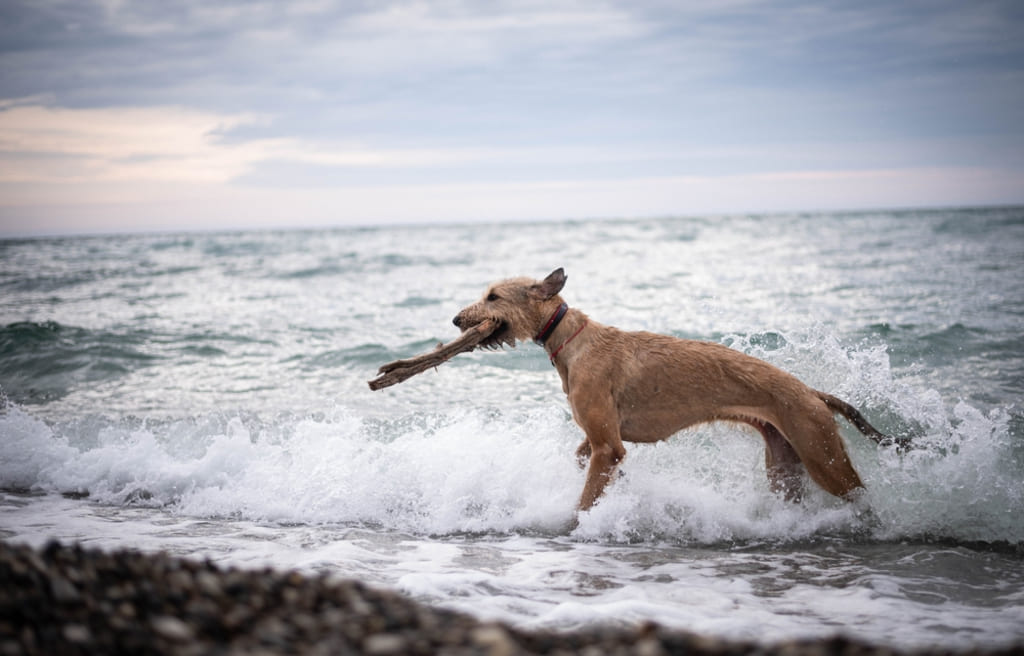
These Hound dogs have a calm and easy-going nature. They adapt well to various activity levels, but regular exercise is essential for their overall well-being.
When properly socialized from a young age, Irish Wolfhounds are usually comfortable around children and other dogs. However, their strong prey drive may lead them to chase smaller animals during walks.
In terms of behavior, these dogs are not excessive barkers, but they will alert you if something seems off. Some may develop separation anxiety, so it’s recommended not to leave them alone for extended periods. Keeping them physically and mentally engaged can help prevent anxiety.
Training this Hound dog is usually smooth as they are attentive to their owners. However, it’s crucial not to slack off in lessons, as this breed can become very large and dominant. Start obedience training early in puppyhood and focus on socializing them for a well-balanced and friendly pet.
Expose your dog to different people and situations from a young age to build comfort and confidence. Leash training is essential, especially if you want them to walk safely with children.
Always opt for positive training methods with Irish Wolfhounds. Harsh corrections or negative experiences can cause these sensitive dogs to shut down and hinder their learning process.
Here are some fun activities to keep them happy:
- Racing
- Tracking
- Agility
- Obedience training
Exercise Needs
Plan to spend about an hour each day getting your Wolfhound moving. They can be great jogging or running partners once their bones are fully developed, and they love long walks and hikes. Engaging them in activities like tracking and agility can keep both their body and mind active.
Given their size, it’s crucial to provide your Wolfhound with daily access to plenty of space. Ideally, a fenced yard would be perfect, allowing them to run freely and stretch their legs.
Keep in mind that these Hound dogs have a strong prey drive as sighthounds, so it’s safest to let them run free only in enclosed areas.
When properly exercised, Irish wolfhounds are generally calm indoors. Some owners even find themselves encouraging their dogs to exercise because these dogs can be quite laid-back. Despite their size, they can adapt to apartment living as long as there’s enough space for everyone and they get the outdoor time they need to release their energy.
Grooming Needs
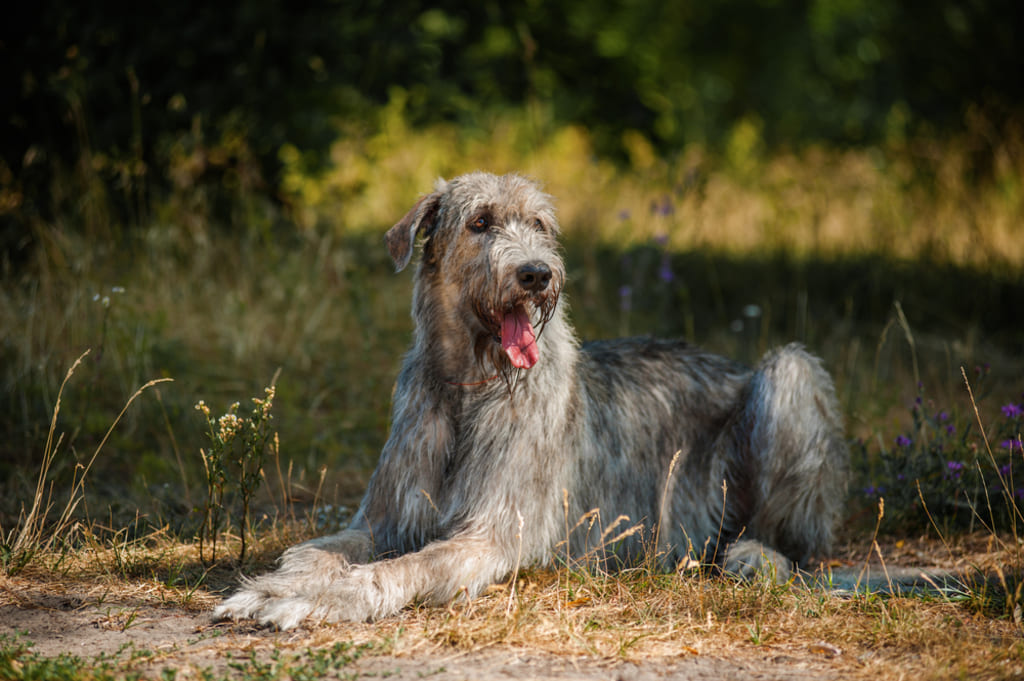
These dogs have a medium-length, wiry coat with minimal grooming requirements. They shed moderately and aren’t known for excessive drooling.
1. Skin Care
No special skin care is needed for Irish Wolfhounds. Bathing every 1-3 months with a dog-specific shampoo designed for wiry hair is sufficient for maintaining cleanliness and appearance.
2. Coat Care
The Irish Wolfhound’s coat is resistant to matting, but regular brushing (weekly) helps remove loose hairs. Hand-stripping, done every six months, involves plucking or using a stripping rake to eliminate dead hair.
3. Eye Care
No specific grooming is required for the eyes. However, if you notice squinting or ocular discharge, it’s essential to consult your veterinarian as these could indicate more serious eye conditions.
4. Ear Care
Cleaning your dog’s ears every 2-4 weeks is a preventive measure against ear infections. If you observe redness or excessive debris, a vet examination is recommended.
5. Dental Health
Brush your Irish Wolfhound’s teeth daily to maintain optimal oral health, preventing dental problems and ensuring healthy teeth and gums.
6. Nail Trim
Trim your dog’s nails once or twice a month. Keeping their nails short reduces the chances of breakage.
Are Irish Wolfhounds Hypoallergenic?
The Irish Wolfhound is not hypoallergenic. While they don’t shed excessively, the dander they produce can trigger allergies. It’s worth mentioning that they release comparatively less dander than some other dog breeds.
Price
Irish Wolfhounds for sale from a reputable breeder can cost around $1,500 to $2,500. If you opt for a show-quality puppy, the price may go up to $3,000 or more. You can also get these dogs from Irish Wolfhound rescue associations.
These dogs are well-known for their athletic abilities, particularly in endurance running. The price can differ based on various factors like the pup’s age, gender, quality, family history, and where the breeder is located.
Life Span
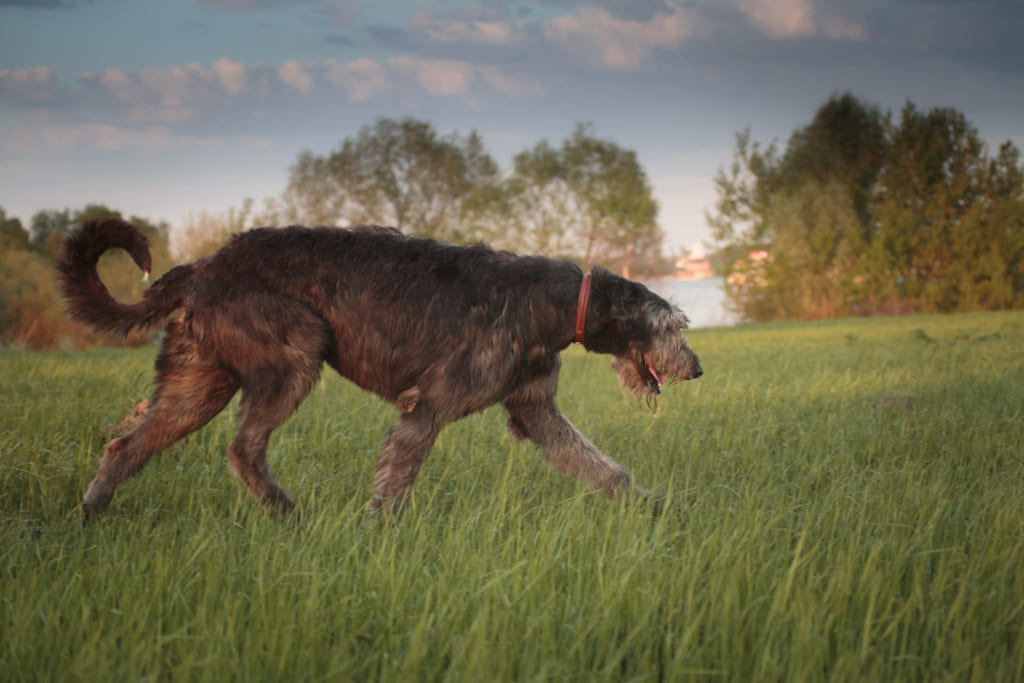
On average, these dogs live between 6 to 8 years, although some have been known to reach up to 12 years. The oldest recorded Irish Wolfhound, named Guinness, was born in 1991 and unfortunately passed away in 2004.
Guinness had a relatively long life for this breed, which typically lives around 8 to 10 years, influenced by their large body size and associated genetic factors.
Yes, you can consider adopting a dog from a nearby Irish Wolfhound rescue shelter.
Visit the internet and search for Irish Wolfhound for sale online to locate the closest breeder.
Irish Wolfhound’s price can go up to $3000, which is expensive in terms of other dogs.
No, these dogs shed only moderately and mostly during the shedding season.
Conclusion
This is all you need to know if you are planning to buy an Irish Wolfhound. These large dogs may appear to be a bit intimidating, but they are actually gentle giants.
They have an easygoing personality and can easily live with families. Despite being bred as hunting dogs, they are very loving and friendly. However, remember that they have shorter lifespans compared to other dogs.
So, if you get an Irish Wolfhound, give them healthy food and invest your time in giving them proper exercise. You also need to take them for regular vet checkups.
In case you Missed it!








